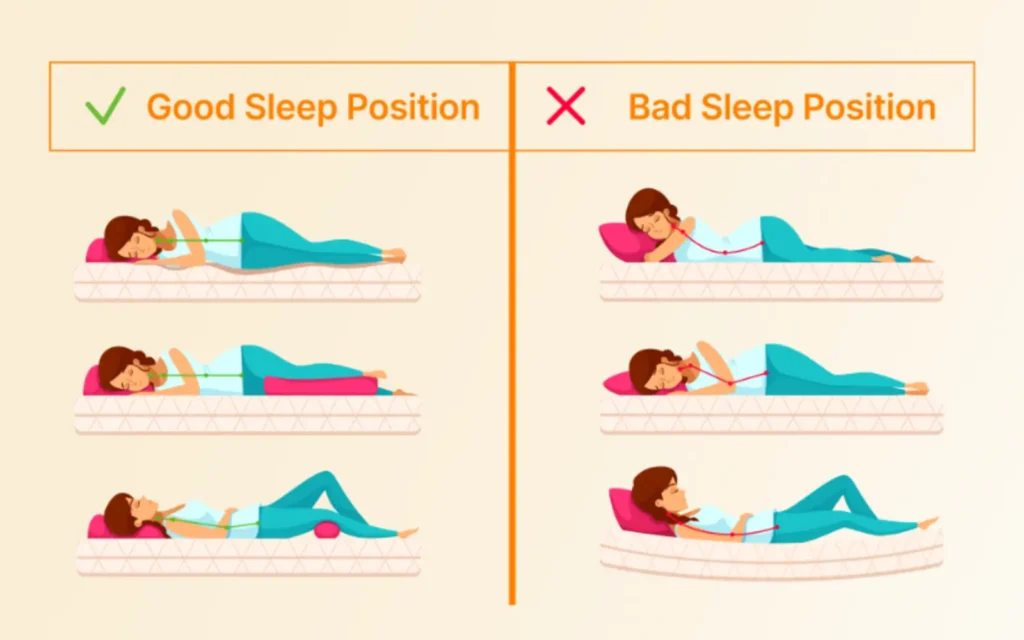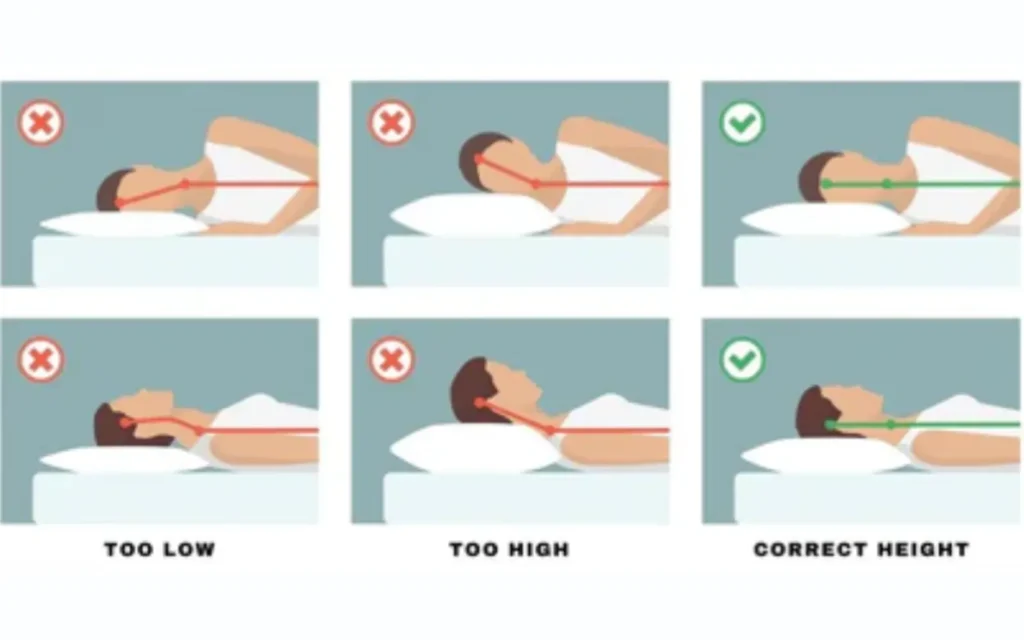Yes, you should sleep if you have neck pain. Rest can help your body heal.
However, finding the right position and support is key. Dealing with neck pain can be frustrating. It impacts your daily routine and even your sleep. Many wonder if it’s safe to sleep with neck pain. The answer is yes, but it’s important to do it right.
Proper sleep can aid recovery, while poor sleep might make it worse. In this post, we will explore how to sleep comfortably with neck pain. We will discuss the best positions, pillows, and tips to ease the discomfort. Ready to find relief and sleep better? Let’s dive in!
Causes Of Neck Pain
Neck pain can make it hard to sleep. It’s important to understand the causes of neck pain to find relief. Various factors can contribute to neck pain, including muscle strain, injuries, and poor posture. Knowing these causes can help you take steps to alleviate the pain and get a good night’s rest.
Muscle Strain
Muscle strain is a common cause of neck pain. It occurs when muscles in the neck are overstretched or torn. This can happen due to:
- Sudden movements
- Heavy lifting
- Sports activities
- Repetitive motions
When muscles are strained, they become sore and stiff. This leads to discomfort and pain. Muscle strain can be mild or severe. Mild strains usually heal with rest and proper care. Severe strains may require medical attention.
To prevent muscle strain:
- Warm up before physical activities.
- Use proper techniques when lifting heavy objects.
- Take breaks to avoid repetitive strain.
- Maintain a healthy posture.
Using a heating pad or taking a warm shower can help relax strained muscles. Gentle stretching exercises can also be beneficial. If the pain persists, consult a healthcare professional for further advice.
Injuries
Injuries can also cause neck pain. These injuries may result from:
- Car accidents
- Falls
- Sports collisions
- Physical assaults
Whiplash is a common neck injury. It happens when the head is suddenly jerked forward and then backward. This rapid motion can damage the soft tissues in the neck. Symptoms of whiplash include:
- Neck pain and stiffness
- Headaches
- Dizziness
- Numbness in the arms
Other injuries, such as fractures or dislocations, can also cause neck pain. These injuries may require immediate medical attention. To minimize the risk of injuries, always wear seat belts in vehicles and use protective gear during sports.
For minor injuries, rest and over-the-counter pain relievers can help. Applying ice packs can reduce swelling. If symptoms worsen or do not improve, seek medical advice promptly.
Poor Posture
Poor posture is another significant cause of neck pain. Slouching or hunching over can strain the neck muscles. Common activities that contribute to poor posture include:
- Looking down at a phone or tablet
- Working at a computer for long hours
- Sitting in an uncomfortable chair
- Sleeping in awkward positions
Maintaining a good posture is crucial for preventing neck pain. Here are some tips:
- Keep your back straight and shoulders relaxed.
- Adjust your computer screen to eye level.
- Use a chair that supports your lower back.
- Take regular breaks to stretch and move around.
- Sleep on a supportive pillow that aligns your neck and spine.
Ergonomic adjustments can make a big difference. Ensure your workspace is set up to encourage good posture. Simple changes can help reduce neck pain and improve overall comfort.

Symptoms To Watch For
Neck pain can disrupt your sleep and affect your daily life. It’s essential to understand the symptoms to determine if you should rest or seek medical help. Pay attention to these key symptoms to make an informed decision about your neck pain.
Persistent Pain
Persistent pain in the neck is a significant symptom to watch for. This type of pain doesn’t go away easily and can be constant or recurring. Persistent neck pain can affect your ability to sleep, work, and perform daily activities. You might experience:
- A dull, aching sensation in your neck
- Sharp or stabbing pain in one area
- Stiffness that limits your range of motion
- Pain that radiates to your shoulders or upper back
Persistent pain can result from poor posture, muscle strain, or an underlying condition like arthritis. If you notice that the pain doesn’t improve with rest or over-the-counter pain relievers, it may be time to see a doctor.
Use a supportive pillow and maintain good posture during sleep to alleviate some of the pain. Try these tips:
- Choose a pillow that keeps your neck aligned with your spine.
- Sleep on your back or side, not your stomach.
- Take breaks during the day to stretch your neck.
If the pain persists, don’t ignore it. Chronic neck pain can lead to more serious issues if not treated properly.
Numbness
Numbness in your neck or arms is another symptom that requires attention. This sensation can feel like pins and needles or a loss of feeling in the affected area. Numbness can indicate nerve compression or damage. Here are some signs to look for:
- Numbness that spreads from your neck to your shoulders, arms, or hands
- Weakness in your arms or hands
- Tingling sensations in your fingers
- Difficulty gripping objects
These symptoms can result from conditions like herniated discs or spinal stenosis. If you experience numbness, it’s crucial to seek medical advice. A doctor can perform tests to determine the cause and recommend treatment options.
To manage numbness at home, consider these tips:
- Practice neck exercises to relieve pressure on nerves.
- Use an ergonomic chair and desk setup.
- Apply heat or cold packs to reduce inflammation.
Persistent numbness should not be ignored, as it can lead to permanent nerve damage if left untreated.
Headaches
Headaches can be a common symptom associated with neck pain. These headaches often start at the base of the skull and can spread to the forehead or behind the eyes. Neck-related headaches can be caused by muscle tension, poor posture, or cervical spine issues. Look for these signs:
- Aching or throbbing pain in the head
- Stiffness in the neck and shoulders
- Pain that worsens with neck movement
- Sensitivity to light or sound
Headaches from neck pain can disrupt your sleep and daily activities. To alleviate these headaches, try these methods:
- Maintain good posture throughout the day.
- Perform gentle neck stretches to reduce tension.
- Take breaks from activities that strain your neck.
- Use a supportive pillow to keep your neck aligned while sleeping.
Headaches caused by neck pain can significantly impact your quality of life. If these headaches persist, consult a healthcare professional to identify the underlying cause and develop an appropriate treatment plan.
Impact Of Sleep On Neck Pain
Restorative Benefits
Neck pain can make it hard to sleep. But sleep is important for healing. Many people ask, “Should I sleep if I have neck pain?” Understanding how sleep affects neck pain can help you make better decisions.
Good sleep helps your body heal. This is especially true for neck pain. During sleep, your muscles relax and repair. This can reduce pain and stiffness.
Here are some restorative benefits of sleep for neck pain:
- Muscle Repair: While you sleep, your muscles repair themselves. This can help reduce neck pain.
- Reduced Inflammation: Sleep helps lower inflammation. Less inflammation means less pain.
- Improved Blood Flow: Good sleep improves blood flow. Better blood flow helps deliver nutrients to your neck muscles.
It is important to create a good sleep environment. This includes:
- Using a supportive pillow
- Sleeping on a firm mattress
- Keeping your neck in a neutral position
Here is a table showing the benefits of sleep positions:
|
Sleep Position |
Benefits |
|
Back Sleeping |
Keeps spine aligned |
|
Side Sleeping |
Reduces snoring and acid reflux |
|
Stomach Sleeping |
Can cause neck pain |
Pain Relief
Sleep can also help reduce pain. When you sleep well, your body produces hormones that can relieve pain. This is important for neck pain sufferers.
Here are some ways sleep can provide pain relief:
- Hormone Production: Sleep helps produce hormones like endorphins. Endorphins can reduce pain.
- Stress Reduction: Good sleep reduces stress. Less stress means less muscle tension and pain.
- Improved Mood: Sleep improves mood. A better mood can help you cope with pain better.
To get the most pain relief from sleep, try these tips:
- Avoid caffeine before bed
- Keep a regular sleep schedule
- Practice relaxation techniques before bed
Here is a table showing tips for a better sleep environment:
|
Tip |
Benefit |
|
Dark Room |
Helps you fall asleep faster |
|
Quiet Environment |
Reduces disturbances |
|
Cool Temperature |
Promotes deeper sleep |

Best Sleep Positions
Neck pain can make it hard to get a good night’s sleep. Finding the right sleep position can help ease your discomfort. Below are some of the best sleep positions to consider if you have neck pain.
Back Sleeping
Sleeping on your back is often recommended for neck pain. This position helps keep your spine aligned. Here are a few tips to make back sleeping more comfortable:
- Use a thin pillow. A thick pillow can push your head too far forward.
- Place a small pillow under your knees. This helps reduce stress on your lower back.
- Consider using a cervical pillow. These pillows have a dip in the middle to support your neck.
Below is a table summarizing the benefits and tips for back sleeping:
|
Benefits |
Tips |
|
Spine alignment |
Use a thin pillow |
|
Reduced neck pain |
Place a small pillow under knees |
|
Less pressure on neck |
Consider a cervical pillow |
Side Sleeping
Side sleeping is another good option for those with neck pain. It can help keep your spine in a neutral position. Here are some tips to make side sleeping more effective:
- Use a firm pillow. This helps keep your neck aligned with your spine.
- Place a pillow between your knees. This can help keep your hips aligned.
- Keep your top leg straight. Bending it too much can twist your spine.
Below is a table summarizing the benefits and tips for side sleeping:
|
Benefits |
Tips |
|
Neutral spine position |
Use a firm pillow |
|
Reduced hip pain |
Place a pillow between knees |
|
Less twisting of spine |
Keep top leg straight |
Avoiding Stomach Sleeping
Stomach sleeping is not recommended for neck pain. This position can strain your neck and spine. Here are some reasons to avoid stomach sleeping:
- Your neck is turned to one side. This can cause muscle strain.
- Your spine is not aligned. This can lead to back pain.
- Increased pressure on joints. This can cause discomfort.
Below is a table summarizing the drawbacks of stomach sleeping:
|
Drawbacks |
|
Neck strain |
|
Misaligned spine |
|
Increased joint pressure |
In summary, choosing the right sleep position can help reduce neck pain. Consider back or side sleeping and avoid stomach sleeping for a better night’s rest.
Choosing The Right Pillow
Neck pain can make it hard to sleep. Choosing the right pillow can help. The right pillow supports your neck and head, keeping your spine aligned. This can reduce pain and improve your sleep. Here are some tips to help you choose the best pillow.

Supportive Pillows
Supportive pillows are designed to keep your neck and spine in a neutral position. This helps reduce neck pain. Look for pillows that offer firm support. They should fill the space between your neck and the mattress.
There are different types of supportive pillows:
- Memory Foam Pillows: These conform to the shape of your head and neck. They provide consistent support.
- Contour Pillows: These have a curved design. They cradle your neck and support your head.
- Cervical Pillows: These are specially designed for neck pain. They have a dip in the center for your head and raised edges for your neck.
A good pillow should help you maintain proper alignment. This is especially important if you sleep on your back or side. A table can help you compare different supportive pillows:
|
Type of Pillow |
Material |
Key Features |
|
Memory Foam |
Foam |
Conforms to shape, consistent support |
|
Contour |
Foam |
Curved design, cradles neck |
|
Cervical |
Foam or Fiber |
Special design for neck pain, dip in center |
Adjustable Options
Adjustable pillows are another great option. These pillows let you change the height and firmness. This is useful if your needs change over time.
Here are some types of adjustable pillows:
- Shredded Memory Foam Pillows: These contain small pieces of memory foam. You can add or remove foam to adjust the height.
- Water Pillows: These have a water chamber. You can add or remove water to change the firmness.
- Buckwheat Pillows: These are filled with buckwheat hulls. You can add or remove hulls to adjust the pillow.
Adjustable pillows are great for people who need flexibility. They let you find the perfect level of support and comfort. Here is a table to help you compare different adjustable pillows:
|
Type of Pillow |
Material |
Key Features |
|
Shredded Memory Foam |
Foam |
Adjust height, customizable firmness |
|
Water |
Water and Fiber |
Adjust firmness, water chamber |
|
Buckwheat |
Buckwheat Hulls |
Adjust height, natural material |
Choosing the right pillow can make a big difference. It can help you sleep better and reduce neck pain. Consider trying a supportive or adjustable pillow to find what works best for you.
When To Seek Medical Help
Dealing with neck pain can be tough, especially when it affects your sleep. Knowing when to seek medical help is important. Some symptoms need a doctor’s attention, while others can be managed at home. Here are some signs that you should not ignore.
Severe Pain
If your neck pain is severe, it might be a sign of a serious problem. Severe pain can make it hard to move your neck or even get out of bed. If your pain is intense, consult a healthcare professional. Here are some situations where severe pain means you need help:
- Sudden and Intense Pain: If the pain starts suddenly and is very strong, it could be an emergency.
- Pain with Other Symptoms: If you have severe pain along with symptoms like fever, vomiting, or weakness, see a doctor.
- After an Injury: If you hurt your neck in an accident, seek medical help to rule out serious injury.
Severe pain can also be a sign of conditions like:
|
Condition |
Description |
|
Herniated Disc |
A disc in your spine may press on a nerve. |
|
Spinal Stenosis |
When the spaces in your spine narrow, it can cause pain. |
|
Infections |
Infections like meningitis can cause severe neck pain. |
Persistent Symptoms
Neck pain that does not go away can be worrying. Persistent symptoms might mean there’s an underlying issue. If your pain lasts more than a week, it’s time to get it checked. Here are some persistent symptoms to watch for:
- Constant Pain: If the pain is always there, it could be a sign of a chronic condition.
- Numbness or Tingling: These symptoms might mean nerve damage.
- Weakness: If you feel weak in your arms or hands, seek medical advice.
Persistent symptoms may indicate conditions such as:
|
Condition |
Description |
|
Osteoarthritis |
Wear and tear in your neck joints can cause ongoing pain. |
|
Fibromyalgia |
This condition causes widespread pain, including in the neck. |
|
Cervical Spondylosis |
Age-related changes in the neck bones can cause persistent pain. |
Remember, persistent neck pain should not be ignored. A healthcare professional can diagnose the cause and recommend treatment.
Home Remedies For Relief
Neck pain can be a real nuisance, especially at night. Finding relief is crucial for a good night’s sleep. Thankfully, there are several home remedies to help ease neck pain and improve your comfort. Here are some effective methods to consider.
Heat Therapy
Heat therapy is a popular method to alleviate neck pain. The warmth helps to relax tight muscles and improve blood flow. This can reduce pain and stiffness. Here are some ways to apply heat therapy:
- Warm Compress: Use a warm towel or a heating pad. Apply it to the sore area for 15-20 minutes.
- Warm Bath: Soaking in a warm bath can soothe neck muscles. Add Epsom salts for added relief.
- Heat Wraps: Heat wraps are available in most pharmacies. They provide consistent heat and can be worn around the neck.
Be cautious with the temperature to avoid burns. Always place a cloth between your skin and the heat source.
Gentle Stretches
Gentle stretches can help to relieve neck pain and improve flexibility. Regular stretching keeps the muscles loose and reduces tension. Here are some easy stretches to try:
- Neck Tilt: Sit or stand with your back straight. Gently tilt your head towards your shoulder and hold for 15-30 seconds. Repeat on the other side.
- Neck Rotation: Slowly turn your head to the right, hold for a few seconds, then turn to the left. Repeat several times.
- Chin Tuck: Sit or stand with your back straight. Slowly tuck your chin towards your chest and hold for 15-30 seconds. Repeat a few times.
Perform these stretches slowly and gently. If you feel any sharp pain, stop immediately.

Lifestyle Changes For Prevention
Neck pain can be a serious discomfort, especially when it disrupts your sleep. While resting might seem like the best solution, lifestyle changes can play a significant role in preventing neck pain. Adopting healthy habits can make a big difference in managing and preventing neck pain.
Ergonomics
Proper ergonomics are crucial for preventing neck pain. Ensuring your workspace is set up correctly can reduce strain on your neck and spine. Here are some tips to improve ergonomics:
- Adjust your chair: Make sure your chair supports your lower back and allows your feet to rest flat on the floor.
- Monitor height: Position your computer monitor at eye level to avoid tilting your head.
- Keyboard and mouse placement: Keep your keyboard and mouse close to prevent overreaching. Your elbows should be at a 90-degree angle.
- Use a headset: If you frequently use the phone, consider a headset to avoid cradling the phone between your ear and shoulder.
Besides your workspace, consider your posture during daily activities. For example, avoid slouching while sitting or standing. Use a firm pillow that supports the natural curve of your neck while sleeping.
|
Activity |
Ergonomic Tip |
|
Working at a desk |
Keep monitor at eye level, use an adjustable chair |
|
Talking on the phone |
Use a headset to keep your neck straight |
|
Reading |
Hold books at eye level to avoid bending your neck |
Regular Exercise
Regular exercise strengthens muscles and improves flexibility, which can help prevent neck pain. A mix of aerobic activities, strength training, and stretching exercises is ideal. Here are some exercises to include in your routine:
- Neck stretches: Gently tilt your head from side to side, forward, and backward to improve flexibility.
- Shoulder rolls: Roll your shoulders forward and backward to relieve tension.
- Chin tucks: Pull your chin towards your chest and hold for a few seconds. This exercise strengthens neck muscles.
- Core strengthening: A strong core supports your neck and spine. Include exercises like planks and bridges.
Aerobic activities like walking, swimming, or cycling can improve overall fitness and reduce neck pain. Aim for at least 30 minutes of aerobic exercise most days of the week.
Remember to warm up before exercising and cool down afterwards. This helps prevent injury and improves flexibility. Regular exercise not only helps prevent neck pain but also promotes overall well-being.
Alternatives To Sleep
Experiencing neck pain can make it difficult to get a good night’s sleep. You might wonder if sleeping is the best option or if there are alternatives to help ease the discomfort. The good news is, there are various ways to manage neck pain besides trying to sleep through it. Here, we will explore some effective alternatives to sleep that can help you feel better.
Short Naps
Sometimes, a full night’s sleep can be hard to achieve with neck pain. Instead, short naps can provide relief without the strain of lying down for too long. Napping for 20-30 minutes can help your body relax and reduce pain.
- Find a comfortable position: Use a supportive pillow or neck roll.
- Set a timer: Limit naps to 20-30 minutes to avoid stiffness.
- Choose the right environment: A quiet, dark room can help you fall asleep quickly.
Short naps can refresh your body and mind. They offer the rest you need without the risk of worsening neck pain.
|
Benefit |
Explanation |
|
Quick Relief |
Short naps can reduce pain and provide immediate relief. |
|
Improved Mood |
Naps can boost mood and help you feel better overall. |
|
Less Strain |
Shorter naps prevent prolonged pressure on the neck. |
Restorative Activities
In addition to short naps, engaging in restorative activities can help manage neck pain. These activities promote relaxation and can ease muscle tension.
- Gentle Stretches: Slowly stretch your neck muscles to improve flexibility.
- Heat Therapy: Use a warm towel or heating pad to relax tight muscles.
- Massage: A gentle massage can increase blood flow and reduce pain.
- Hydration: Drinking water helps maintain muscle health.
Restorative activities can be done throughout the day to keep pain at bay. They are simple yet effective ways to manage discomfort without needing to sleep.
|
Activity |
Benefit |
|
Gentle Stretches |
Increases flexibility and reduces stiffness. |
|
Heat Therapy |
Relaxes muscles and eases pain. |
|
Massage |
Boosts blood flow and alleviates soreness. |
|
Hydration |
Keeps muscles healthy and reduces cramps. |
These activities are easy to incorporate into your daily routine. They can significantly reduce neck pain and improve your quality of life.

Frequently Asked Questions
Can I Sleep With Neck Pain?
Yes, you can. Rest helps your body heal.
What Sleeping Position Is Best For Neck Pain?
Sleeping on your back or side is best. Avoid sleeping on your stomach.
How Can I Relieve Neck Pain Before Bed?
Use a supportive pillow and apply a warm compress.
Should I See A Doctor For Neck Pain While Sleeping?
Yes, if pain persists or worsens. It could be a serious issue.
Conclusion
Sleep can help you recover from neck pain. Ensure proper support for your neck. Use a suitable pillow and mattress. Avoid sleeping on your stomach. Try gentle stretches before bed. Consult a healthcare provider if pain persists. Rest is crucial for healing.
Listen to your body. Prioritize comfort and good sleep habits. A restful night can aid recovery.

